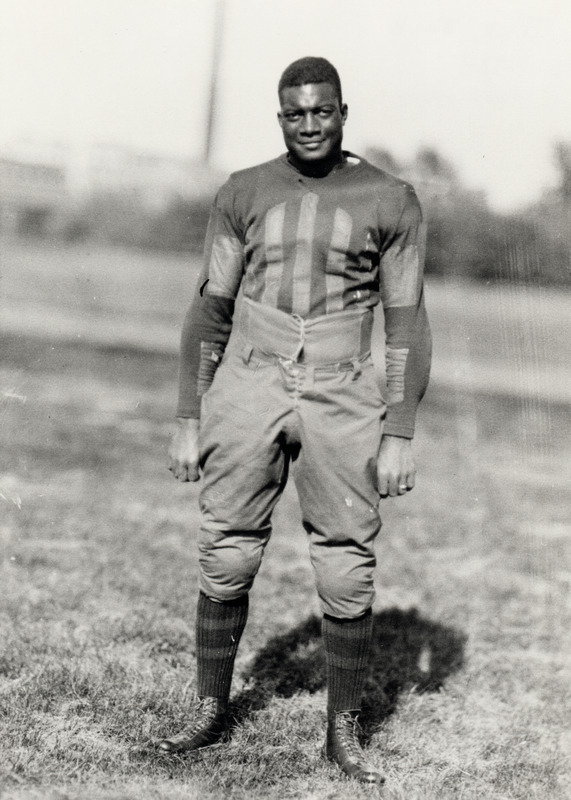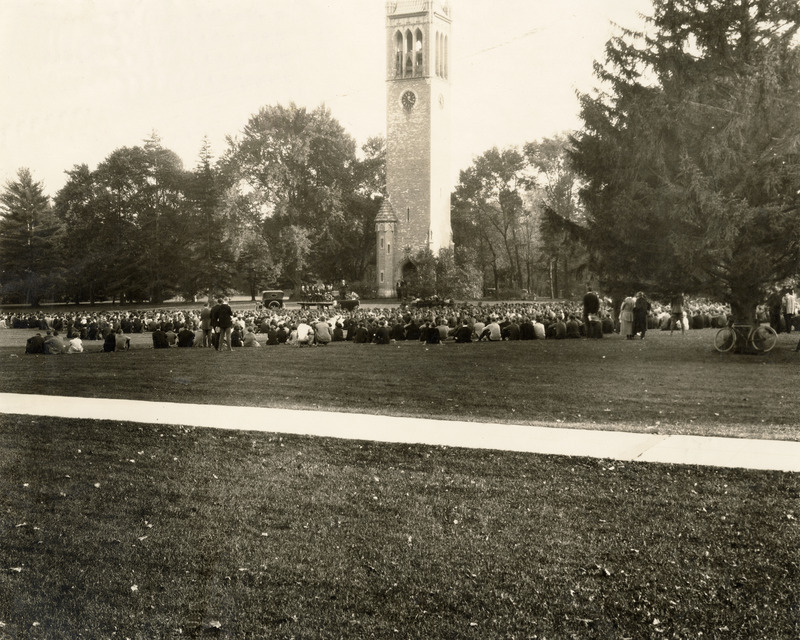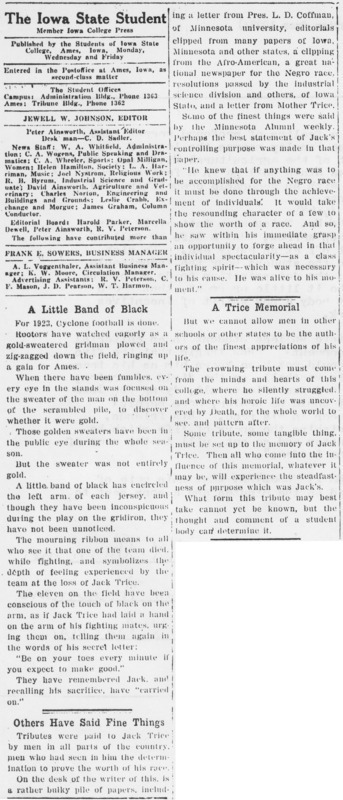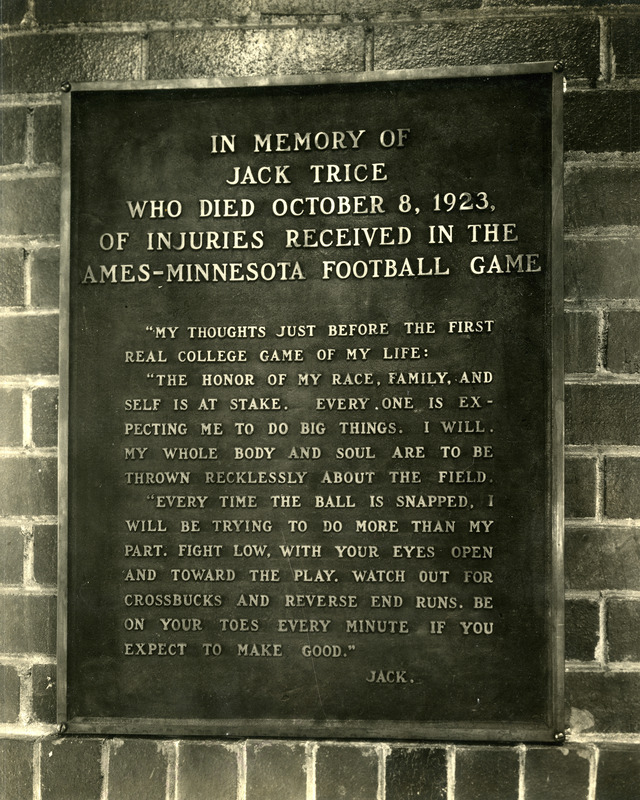The Jack Trice Story
John “Jack” G. Trice was born on May 12, 1902, to Green and Anna Trice in Hiram, Ohio. He attended East Tech High School while living with his uncle in Cleveland. By his senior year, Trice had become a star athlete, playing on back-to-back undefeated teams.

After the season’s end, Trice’s high school coach Sam Willaman was hired by Iowa State to coach football. He recruited six East Tech players to Ames, including Trice. That summer, Trice married Cora Mae Starlard. Trice entered Iowa State College in the fall of 1922 as a non-collegiate two-year agriculture student and, by the winter semester, had transitioned to a full-time student studying animal husbandry while participating in football, track, and the Alpha Phi Alpha fraternity.
On October 5, 1923, the Cyclone football team traveled to Minneapolis to play the University of Minnesota. That night, in the Curtis Hotel, Trice penned his now famous “I will!” letter. The next day, during the first half of the game, Jack was injured—later to be reported as a broken collarbone—but returned to the game. As he was working to disrupt a play in the third quarter, he was trampled and severely injured. Trice was helped off the field, taken to a hospital to be examined, and cleared to return to Ames with his team. Shortly after arriving, he was admitted to the college hospital but passed away on October 8, 1923, from complications caused by the injury to his abdomen.
Trice’s last letter, written the night before the fateful game against Minnesota, was found in his jacket pocket after his death. The letter was read during his memorial service, and copies were sent to media outlets announcing his death. The words written in this letter have served as a testament to his character and inspiration for generations of Iowa Staters.

THE CURTIS HOTEL
MINNEAPOLIS
To whom it may concern:-
My thoughts just before the first real college game of my life. The honor of my race, family, and self are at stake[.] Everyone is expecting me to do big things. I will! My whole body and soul are to be thrown recklessly about on the field tomorrow. Every time the ball is snapped I will be trying to do more than my part[.]

On all defensive plays I must break thru the opponets [sic] line at [sic] stop the play in their territory. Beware of mass interference fight low with your eyes open and toward the play. Roll block the interference[.] Watch out for cross bucks and reverse end runs. Be on your toes every minute if you expect to make good.
In the days following Trice’s death on October 8, 1923, the Iowa State community came together in support of Trice and his family. Campus-wide activities were postponed, classes were suspended, and a memorial service was held on the lawn outside the campanile.

Nearly 3,000 people gathered, forming a semi-circle around a wooden platform holding the casket of Trice draped in a cardinal and gold blanket.
Among the speakers were R. A. Pearson (President), Dr. O. H. Cessna (College Chaplin), J. E. Foster (Dean of Men), C. S. McElyea (President of the Cardinal Guild), and Ira Young (Captain of the football team). His virtues as a student, athlete, and person were lauded, and the service concluded with the reading of Trice’s last letter by President Pearson.
The Iowa State community, including the Ames Chamber of Commerce and Cardinal Guild, raised over $2,000 (the equivalence of over $30,000 today) for the Trice family to cover funeral expenses. The community’s generosity also allowed Cora Mae Trice, Jack’s widow, to pay off their home mortgage with money left in reserve.
Trice’s body was accompanied by Cora Mae Trice (widow), Anna W. Trice (mother), Lee Trice (uncle), Harold L. Tutt (Alpha Phi Alpha fraternity brother), and William H. Thompson (Freshman Coach). Trice’s funeral was held in Ravenna, Ohio, and the body was interred at Fairview Cemetery, Hiram, Ohio.
Even in their deepest sorrow, Trice’s family recognized the support of the Iowa State community. Their appreciation for the kindness they were shown is reiterated throughout the correspondence surrounding his death.

For the rest of the 1923 football season, each of Trice’s former teammates paid tribute to him with a black mourning ribbon tied around their left arm. This visible eulogy stood in contrast to their gold jerseys and heartened them to demonstrate Trice’s fighting spirit on the field. Football Captain Ira Young is quoted in the Jack Trice memorial issue of The Iowa State Student as saying about Trice, “He fought harder than the rest of us; he gave more than the rest of us; he gave his life for Ames.”

Still, the student body wanted to establish a memorial beyond what could be carried by Trice’s former teammates on the gridiron. They sought to create something “tangible” to pay tribute to Trice and to influence those who encountered it by introducing them to Trice’s ideals. A month after Trice’s death, the memorial had not yet been conceptualized, but it was clear that the students of Iowa State would be instrumental in its realization.
In 1924, a commemorative plaque was mounted in State Gym. It contained the date and cause of Trice’s death and an excerpt from his last letter. Over the years, this tangible remembrance, cast in bronze, was forgotten, covered in grime, and hidden behind a staircase.
Over 30 years later, this plaque was rediscovered by Tom Emmerson, an undergraduate journalism student at Iowa State. Emmerson, interested to learn more about Trice, looked to the Athletic Department only to discover that despite the plaque, Trice’s story had been forgotten. Emmerson went to the library to research Trice and ultimately wrote the article “Jack Trice – Victor on a Fatal Field” in the November 1957 issue of The Iowa State Scientist. The cover story garnered little student interest at the time.

